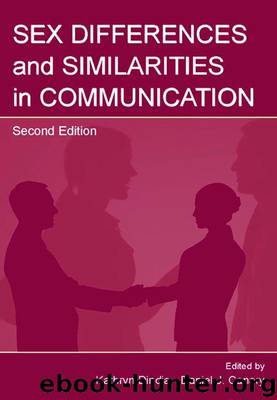Sex Differences and Similarities in Communication by Kathryn Dindia & Daniel J.Canary

Author:Kathryn Dindia & Daniel J.Canary
Language: eng
Format: epub
ISBN: 978-1-135-21680-1
Publisher: Taylor & Francis
SIMILARITIES IN LANGUAGE
Sex-Guess Accuracy
Our research has shown that the language used by women and men in the United States is remarkably similar. In fact, it is so indistinguishable that native speakers of American English cannot correctly identify which language examples were produced by women and which were produced by men. Support for this claim comes from our empirical investigations of female-male language differences and the effects of those differences. We felt there was a need to learn whether readers could determine the sex of the speakers, because if they could, then other respondents might be influenced by gender stereotypes when they rated the speakers. In other words, if raters could determine that a given speaker was a man, they might rate him higher on strength and aggressiveness, purely because of their stereotypical view that men exhibit these attributes, without regard to how his language use made him appear. In contrast, if they could not correctly identify speaker sex, they could not be influenced by stereotypes.
In our first study that measured sex-guess accuracy (Mulac & Lundell, 1980), we recorded brief landscape photograph descriptions by 48 speakers from each of four age groups (six male and six female speakers from each group): (a) public-school fifth graders, (b) university freshmen and sophomores, (c) university teaching assistants and instructors, and (d) people in their 50s and 60s. We had 1-minute segments from these recordings transcribed orthographically and printed, one to a page, with arbitrary speaker numbers (e.g., speaker number 24). We then asked beginning university communication students, for whom English was their first language, to guess the sex of the speakers from each of the age groups. Results showed that they were not able to do so with anything better than chance accuracy.
In our second study (Mulac & Lundell, 1982), we recorded 30 students giving their first speech in a university public-speaking class. On the basis of 1-minute samples of their transcripts, university students were unable to guess the sex of the speakers. Our third study (Mulac et al., 1985) involved the recording of 12 secondary teachers and college instructors from across the country as they described landscape photographs. Once again, university students were unable to distinguish male from female speakers. We found the same result for the essays of 96 4th-, 8th-, and 12th-grade students, who wrote on the topic, Is it ever all right to tell a lie? (Mulac, Studley, & Blau, 1990). Finally, in our fourth study (Mulac & Lundell, 1994), we reported a similar finding for university students impromptu essays describing landscape photographs.2
These consistent results provide clear evidence that the spoken and written language used in everyday communication by women and men, as well as by girls and boys, displays a high degree of similarity.
Download
This site does not store any files on its server. We only index and link to content provided by other sites. Please contact the content providers to delete copyright contents if any and email us, we'll remove relevant links or contents immediately.
Should I Stay or Should I Go? by Ramani Durvasula(7562)
Why We Sleep: Unlocking the Power of Sleep and Dreams by Matthew Walker(6618)
Fear by Osho(4660)
Flow by Mihaly Csikszentmihalyi(4634)
Rising Strong by Brene Brown(4377)
Why We Sleep by Matthew Walker(4360)
The Hacking of the American Mind by Robert H. Lustig(4318)
How to Change Your Mind by Michael Pollan(4292)
Too Much and Not the Mood by Durga Chew-Bose(4272)
Lost Connections by Johann Hari(4098)
He's Just Not That Into You by Greg Behrendt & Liz Tuccillo(3831)
Evolve Your Brain by Joe Dispenza(3610)
The Courage to Be Disliked by Ichiro Kishimi & Fumitake Koga(3414)
Crazy Is My Superpower by A.J. Mendez Brooks(3329)
In Cold Blood by Truman Capote(3306)
Resisting Happiness by Matthew Kelly(3301)
What If This Were Enough? by Heather Havrilesky(3274)
The Book of Human Emotions by Tiffany Watt Smith(3238)
Descartes' Error by Antonio Damasio(3230)
